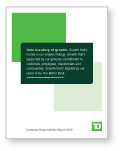Key Performance Indicators
-
Our 2010 Measures of TD’s Performance in Corporate Responsibility
Customers 2010 2009 2008 Customer Experience Index1 TD Canada Trust 30.6 
27.0 26.1 TD Bank 30.8 
32.5 28.3 Number of substantiated breaches of customer privacy or loss of customer data (in Canada) 5 5 2
1 Customer experience is measured through a third-party survey conducted throughout the year to measure how likely a customer is to recommend TD to a friend or colleague. The Customer Experience Index (CEI) is measured based on a Net Promoter Score™ which is calculated based on the response to the question “Thinking about the entire experience you had during your most recent visit to the branch, how likely are you to recommend TD to a friend or colleague?” The Net Promoter Score is the percentage of customers who are promoters less the percentage of customers who are detractors.
Environment 2010 2009 2008 GHG emissions1 - tonnes of CO2e - 253,258 
264,370 Paper usage2 (average paper sheets used per employee) 8,885 8,308 8,473 Electronic waste recycled (metric tonnes) 92.6 60.0 49.3
1 Latest available data is 2009.
2 2009 and 2010 results include Canadian and U.S. operations and employee headcount. 2008 results include Canadian operations and employee headcount.
Employees 2010 2009 2008 Employee retention1 (%) Canada2 88.02 
89.41 86.56 U.S.3 71.89 
73.41 85.80 Employee engagement TD Bank Group4 4.15 
4.11 4.18 Average days of training per employee per year TD Bank Group5 5.81 3.90 3.88 Workplace accident statistics in Canada6 Minor injuries (# of incidents)7 - 199 235 Disabling injuries (# of incidents)8 - 49 85
1 Employee retention is measured as 100 minus the turnover rate. The turnover rate is total terminations (voluntary, involuntary and retirement) divided by the number of full-time and part-time employees.
2 Includes all Canadian businesses except TD General Insurance as data is not available and cannot be estimated.
3 Includes all U.S. businesses except The South Financial Group as this data is not available and cannot be estimated.
4 2010 excludes The South Financial Group as the data is not available and cannot be estimated.
5 2010 excludes The South Financial Group as the data is not available and cannot be estimated. 2009 and 2008 exclude data from TD Bank as the data is not available and cannot be estimated. An average day is considered 7 hours for U.S. employees and 7.5 for all other employees.
6 Latest data available. The 2010 data will be reported to the Canadian government in spring 2011.
7 Injuries that are treated in the workplace, with no time lost beyond the day of the injury.
8 Injuries that result in lost time in the workplace on any day following the injury. For each of the years shown, there were no workplace fatalities or disabling injuries that resulted in permanent loss of use of a body part or function.
Diversity1 2 3 2010 2009 2008 2007 Canada Women Women in senior management4 positions (%) - 33.13 
33.78 29.55 Women in middle and other management5 positions (%) - 46.63 
47.17 47.37 Overall (%) - 65.60 
66.18 66.88 Visible minorities6 Visible minorities in senior management4 positions (%) - 8.59 
8.10 7.20 Visible minorities in middle and other management5 positions (%) - 18.18 
18.73 18.03 Overall (%) - 26.14 
25.97 25.38 Persons with disabilities6 – overall (%) - 3.61 
3.73 3.78 Aboriginal Peoples6 – overall (%) - 1.07 
1.06 1.22
1 Represents the amounts reported to the Canadian federal government as at December 31. Statistics for 2010 will be compiled and reported to the federal government by June 2011.
2 Includes all Canadian businesses except TD General Insurance as this entity is provincially regulated.
3 Includes full-time and part-time employees.
4 Senior Management includes TD job levels Vice President and above who have signing authority.
5 See glossary for definition of Middle and Other Management.
6 Data is voluntarily disclosed by employees.
Community Target 2010 2009 2008 Canada % of five-year average pre-tax profits donated to charities and other community organizations1 1%2 1.4 
1.3 1.4 % of donations/sponsorships given to focus areas 50% 55 49 45 Dollars paid through employee volunteer grants (in thousands) 400 409 336 257 Dollars donated or raised by TD employees (in millions) - 11.1 9.4 6.8 U.S.3 % of net pre-tax income donated to charities and other community organizations4 1%5 1.03 
1.35 -6 % of TD Charitable Foundation giving in focus areas 50% 47 48 - Financial literacy and education programs - 4,600 5,118 - Corporate and employee contributions to United Way and United Way agencies (in millions of US dollars) 1.2 1.4 -
1 Includes the average audited pre-tax profits of the five years ended 2009. Excludes donations made in-kind and program management costs.
2 Target provided by Imagine Canada.
3 U.S. Community Giving figures are reported for TD Bank. They do not include our other businesses in the U.S., such as TD Securities. In-kind donations do not occur and program management costs are excluded.
4 Percentage of net pre-tax income of TD Bank donated – is the amount paid to charities by the TD Charitable Foundation for the period ended October 31 divided by the audited net pre-tax income of TD Bank for the period ended October 31. Net pre-tax income – is pre-tax income excluding intangible amortization and integration costs (costs related to acquisition integration)
5 Target provided by the Giving USA Foundation. The average percentage of net pre-tax income donated by U.S. companies in 2009.
6 TD Bank was established in 2009 therefore no numbers are reported for 2008.


